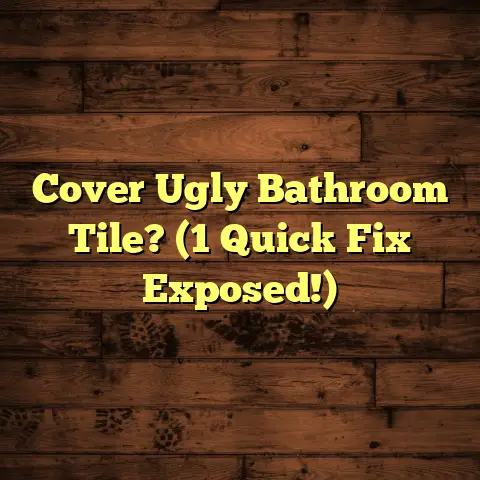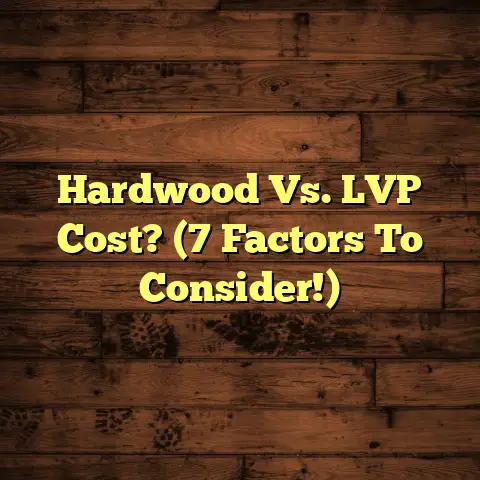Can You Stain Vinyl Floors? (5 Step Pro Guide!)
And one question I get asked a lot is: “Can you stain vinyl floors?”
It’s a good question!
Vinyl flooring has become incredibly popular.
It’s affordable, durable, and comes in so many styles.
But can you actually change its color?
Let’s dive into the world of vinyl staining.
I’ll share my pro guide, tips, and tricks.
Introduction: The Innovation of Vinyl Flooring
Flooring has come a long way, hasn’t it?
From simple wooden planks to complex tile designs, it’s always evolving.
Vinyl flooring is one of the biggest innovations.
It has transformed the way we approach home design.
Early vinyl was pretty basic, but today’s vinyl is a different beast.
Technological advancements have made it incredibly durable.
It also has amazing aesthetics and versatility.
Luxury vinyl tile (LVT) and plank (LVP) can mimic real hardwood.
It also mimics stone and tile so convincingly that it’s hard to tell the difference.
This makes it a fantastic option for any decor style.
And unlike real wood or stone, vinyl is water-resistant and easier to maintain.
That’s why it’s become a favorite for kitchens, bathrooms, and basements.
Section 1: Understanding Vinyl Flooring
So, what exactly is vinyl flooring?
And what makes it so special?
Let’s break it down.
What is Vinyl Flooring?
Vinyl flooring is a synthetic flooring made from polyvinyl chloride (PVC) and other compounds.
It’s designed to be resilient, affordable, and attractive.
There are three main types:
Sheet Vinyl: This comes in large rolls, perfect for covering entire rooms with minimal seams.
It’s great for bathrooms and kitchens where water resistance is key.Vinyl Tile: Individual tiles that can be arranged in various patterns.
It offers more design flexibility compared to sheet vinyl.Luxury Vinyl Tile/Plank (LVT/LVP): These are designed to mimic the look of natural materials like wood and stone.
They often have a thicker wear layer for added durability.
How Vinyl Flooring is Manufactured
Vinyl flooring is made up of several layers:
Wear Layer: The top layer protects the floor from scratches, stains, and wear.
The thicker the wear layer, the more durable the flooring.-
Print Layer: This layer provides the visual design, whether it’s a wood grain, stone pattern, or a solid color.
Core Layer: This provides the flooring’s stability and structure.
It can be made of solid vinyl, composite materials, or even waterproof cores in some luxury options.-
Backing Layer: The bottom layer provides cushioning and helps the flooring adhere to the subfloor.
Common Uses and Benefits
Vinyl flooring is used everywhere from homes to hospitals.
It’s popular because of its many benefits:
- Affordability: Vinyl is typically less expensive than hardwood, tile, or stone.
- Ease of Installation: Many vinyl products are designed for DIY installation with click-lock systems or peel-and-stick options.
- Water Resistance: Vinyl is highly water-resistant, making it ideal for moisture-prone areas.
- Durability: With a good wear layer, vinyl can withstand heavy foot traffic and resist scratches and stains.
- Low Maintenance: Vinyl is easy to clean and requires minimal upkeep.
Section 2: The Concept of Staining Vinyl Floors
Now, let’s get to the heart of the matter: staining vinyl.
Staining and Aesthetic Appeal
Staining is a process traditionally used to enhance the color and grain of wood.
It penetrates the surface, adding depth and richness.
It can transform a dull piece of wood into a stunning focal point.
With flooring, staining can bring out the natural beauty of the material.
It can also change the entire look of a room.
Common Misconceptions
Here’s where things get tricky.
Many people believe that vinyl can’t be stained because it’s plastic.
And in its purest form, that’s true.
Vinyl is non-porous, meaning it doesn’t easily absorb liquids.
Traditional wood stains won’t work on most vinyl floors.
Factors Influencing Stainability
However, not all vinyl is created equal.
Some vinyl floors have a more porous surface.
This is especially true for older vinyl or vinyl with a textured wear layer.
The age of the vinyl also plays a role.
Over time, the surface can become more receptive to staining.
Wear and tear can create micro-abrasions that allow stain to penetrate.
So, while it’s not the same as staining wood, it is possible to alter the color of some vinyl floors.
Section 3: Assessing the Condition of Your Vinyl Floors
Before you even think about picking up a stain, you need to assess your floor.
Thorough Checklist
Here’s what I look for when evaluating vinyl floors for staining:
Level of Wear and Tear: Are there heavy scratches, gouges, or areas where the wear layer is completely worn through?
If so, staining might not be the best solution.
The wear layer will be damaged and exposed to everything.Scratches, Dents, and Discolorations: Minor scratches might be covered with stain, but deep dents won’t disappear.
Discolorations can affect how the stain is absorbed.Cleanliness and Coatings: Is the floor clean and free of wax, polish, or other coatings?
These can prevent the stain from adhering properly.Type of Vinyl: What type of vinyl do you have?
Sheet vinyl is completely different than LVP.
Testing Porosity
To understand how well your vinyl will absorb stain, do a simple test:
- Clean a small, inconspicuous area of the floor.
- Apply a small amount of water to the surface.
- Observe how the water behaves.
If the water beads up and sits on the surface, the vinyl is non-porous.
It won’t absorb stain well.
If the water slowly soaks in or spreads out, the vinyl has some porosity.
It may be suitable for staining.
Section 4: The 5-Step Pro Guide to Staining Vinyl Floors
Alright, let’s get to the good stuff!
If you’ve assessed your floor and think it’s a good candidate for staining, follow these steps.
1. Preparation and Tools Required
Tools and Materials:
- Cleaning Supplies:
- Broom or vacuum
- Mop
- Bucket
- Mild detergent (dish soap works great)
- Degreaser (if needed)
- Rubbing alcohol
- Clean cloths or rags
- Stain Selection:
- Water-based stain (I recommend this for most vinyl)
- Gel stain (for a thicker, more even application)
- Specialized vinyl stain (if you can find it)
- Applicators:
- Foam brushes
- Lint-free cloths
- Small paint roller (for larger areas)
- Paint tray
- Safety Gear:
- Gloves
- Eye protection
- Respirator (especially if using solvent-based stains)
- Other:
- Painter’s tape
- Drop cloths or plastic sheeting
- Sandpaper (fine-grit, for light scuffing)
- Sealer (polyurethane or acrylic)
Preparation Guide:
- Clear the Room: Remove all furniture, rugs, and other items from the room.
- Protect Surroundings: Use painter’s tape and drop cloths to protect baseboards, walls, and other surfaces.
- Clean the Floor Thoroughly:
- Sweep or vacuum to remove loose dirt and debris.
- Mop the floor with a solution of mild detergent and warm water.
- If there’s grease or grime, use a degreaser.
- Rinse the floor with clean water and let it dry completely.
- Address Repairs:
- Fill any cracks or holes with a vinyl repair kit.
- Smooth out any rough spots with fine-grit sandpaper.
- Clean the repaired areas with rubbing alcohol to remove dust.
- Lightly Scuff the Surface:
- Use fine-grit sandpaper to lightly scuff the surface of the vinyl.
- This will help the stain adhere better.
- Be careful not to sand too hard, as you could damage the wear layer.
- Vacuum up the sanding dust and wipe the floor with a damp cloth.
2. Choosing the Right Stain
The type of stain you choose is crucial for success.
- Water-Based Stains:
- These are my go-to for vinyl.
- They’re low in VOCs, easy to clean up, and generally safe to use.
- They penetrate the vinyl slightly, providing a subtle color change.
- Oil-Based Stains:
- I usually avoid these on vinyl.
- They don’t adhere well and can create a sticky mess.
- They also have strong odors and require special disposal.
- Gel Stains:
- These are a good option for vinyl because they sit on the surface.
- They provide a more even color and are less likely to streak.
- They’re also easy to apply and control.
- Specialized Vinyl Stains:
- These are rare, but if you can find them, they’re worth considering.
- They’re specifically formulated to adhere to vinyl surfaces.
- Follow the manufacturer’s instructions carefully.
Color Selection Tips:
- Consider Existing Decor: Choose a stain color that complements your existing furniture, walls, and accessories.
- Think About the Overall Atmosphere: Light colors can make a room feel brighter and more spacious.
Dark colors can create a cozy and intimate atmosphere. - Test the Stain: Always test the stain on a small, inconspicuous area of the floor before applying it to the entire surface.
This will give you a better idea of how the color will look and how well it adheres. - Layer Colors: You can create custom colors by layering different stains.
Apply one color, let it dry, and then apply another color on top.
3. Applying the Stain
Here’s the step-by-step process for applying the stain:
- Protect Yourself: Wear gloves and eye protection.
If using a solvent-based stain, wear a respirator. - Ventilate the Room: Open windows and doors to provide plenty of fresh air.
- Apply the Stain:
- Dip a foam brush or lint-free cloth into the stain.
- Apply a thin, even coat to the vinyl surface.
- Work in small sections, following the grain pattern (if any).
- Avoid applying too much stain at once, as this can lead to streaks and uneven coverage.
- Wipe Off Excess Stain:
- After a few minutes, use a clean, lint-free cloth to wipe off any excess stain.
- This will help to prevent the stain from drying unevenly.
- Continue wiping until the desired color is achieved.
- Let the Stain Dry:
- Allow the stain to dry completely according to the manufacturer’s instructions.
- This can take anywhere from a few hours to overnight.
- Avoid walking on the floor during the drying process.
- Apply Additional Coats (Optional):
- If you want a darker or more intense color, apply additional coats of stain.
- Allow each coat to dry completely before applying the next.
Tips for an Even Finish:
- Work in Small Sections: This will help you to control the application and prevent streaks.
- Use a Light Touch: Avoid pressing too hard with the brush or cloth, as this can create uneven coverage.
- Overlap Strokes: Overlap each stroke slightly to ensure that the entire surface is covered.
- Keep a Wet Edge: When working in sections, keep a wet edge to prevent the stain from drying before you can blend it in.
- Use a Foam Brush for Edges: Use a small foam brush to apply stain to the edges and corners of the floor.
4. Sealing the Stain
Sealing the stained vinyl is essential to protect it from wear and tear.
It also helps to lock in the color and prevent it from fading.
Choosing the Right Sealant:
- Polyurethane: This is a durable sealant that provides excellent protection against scratches, stains, and water damage.
It’s a good choice for high-traffic areas. - Acrylic: This is a less durable sealant that’s easier to apply and clean up.
It’s a good choice for low-traffic areas. - Water-Based vs.
Oil-Based: Water-based sealants are low in VOCs and easy to clean up.
Oil-based sealants are more durable but have strong odors and require special disposal.
- Polyurethane: This is a durable sealant that provides excellent protection against scratches, stains, and water damage.
Application Process:
- Clean the Floor: Make sure the floor is clean and dry before applying the sealant.
- Apply the Sealant: Use a foam brush, paint roller, or sprayer to apply a thin, even coat of sealant to the vinyl surface.
- Let the Sealant Dry: Allow the sealant to dry completely according to the manufacturer’s instructions.
This can take anywhere from a few hours to overnight. - Apply Additional Coats (Optional): For added protection, apply additional coats of sealant.
Allow each coat to dry completely before applying the next.
-
Ensuring Optimal Adhesion and Durability:
- Follow the Manufacturer’s Instructions: Always follow the manufacturer’s instructions for the sealant you’re using.
- Prepare the Surface Properly: Make sure the floor is clean, dry, and lightly scuffed before applying the sealant.
- Apply Thin Coats: Applying thin coats of sealant will help to prevent drips, runs, and bubbles.
- Allow Sufficient Drying Time: Allow the sealant to dry completely before walking on the floor or placing furniture on it.
5. Maintenance Tips for Stained Vinyl Floors
Once your vinyl floors are stained and sealed, you’ll want to keep them looking their best.
Regular Cleaning:
- Sweep or Vacuum Regularly: Sweep or vacuum the floor regularly to remove dirt, dust, and debris.
- Mop with Mild Detergent: Mop the floor with a solution of mild detergent and warm water.
Avoid using harsh chemicals or abrasive cleaners, as these can damage the sealant. - Wipe Up Spills Immediately: Wipe up spills immediately to prevent staining.
-
Safe Cleaning Products:
- Mild Dish Soap: A few drops of mild dish soap in warm water is a safe and effective cleaner for stained vinyl floors.
- Vinegar and Water: A solution of equal parts vinegar and water can be used to clean and disinfect the floor.
- Specialized Vinyl Cleaners: There are also specialized vinyl cleaners available that are designed to be gentle and effective.
-
Preventative Measures:
- Use Rugs and Mats: Place rugs and mats in high-traffic areas to protect the floor from scratches and wear.
- Use Furniture Pads: Place furniture pads under the legs of furniture to prevent scratches and dents.
- Avoid Sharp Objects: Avoid walking on the floor with sharp objects, such as high heels or cleats.
- Trim Pet’s Nails: Keep your pet’s nails trimmed to prevent scratches.
Section 5: Troubleshooting Common Issues
Even with the best preparation, things can sometimes go wrong.
Here are some common issues and how to fix them:
Uneven Application:
- Problem: The stain is applied unevenly, resulting in blotchy or streaky areas.
- Solution: Use a clean cloth to blend the stain and even out the color.
If the stain has already dried, lightly sand the affected area and reapply the stain.
Staining Failure:
- Problem: The stain doesn’t adhere to the vinyl or the color doesn’t change.
- Solution: Make sure the floor is properly cleaned and prepared.
Lightly scuff the surface with fine-grit sandpaper to improve adhesion.
Try using a different type of stain or a specialized vinyl stain.
Bubbling:
- Problem: Bubbles appear on the surface of the stain.
- Solution: This is usually caused by applying too much stain or not allowing it to dry properly.
Use a clean cloth to gently pop the bubbles and smooth out the surface.
Allow the stain to dry completely before applying a sealant.
Conclusion: The Benefits of Staining Vinyl Floors
Staining vinyl floors can be a fantastic way to refresh and customize your space without breaking the bank.
It allows you to:
- Update the Look: Change the color of your floors to match your decor or create a new aesthetic.
- Save Money: Avoid the cost of replacing your floors entirely.
- DIY Project: Take on a rewarding DIY project that can transform your home.
With the right preparation, materials, and techniques, staining vinyl flooring can be a successful and satisfying project for both seasoned and novice home improvers.
Call to Action
Have you ever tried staining vinyl floors?
What was your experience like?
Share your tips, questions, and stories in the comments below!
And if you’re looking for more home improvement advice, be sure to check out my other articles and videos.
Let’s make our homes beautiful, one floor at a time!





